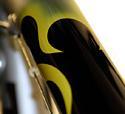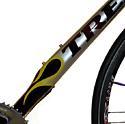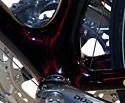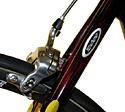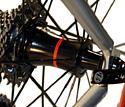
Recently on Cyclingnews.com |
Tech review - November 11, 2004
On test: Trek Madone 5.9 Project One
Peloton workhorse
Introduced during the 2003 Tour de France, the Trek Madone 5.9 was the first of a whole new range of carbon bikes that have gradually replaced the venerable 5XXX series at the top of the Trek range. John Stevenson hit the road on one to find out what makes it tick.
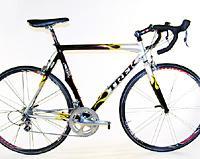
|
Trek's Madone series of carbon fiber bikes made its debut in the 2003 Tour de France and in one incarnation or another Madones have since become the official bikes of Lance Armstrong and the US Postal team (the Discovery Channel team from 2005). With the range expanded to three frames for 2005, the Madone 5.9 is still the bike billed as US Postal's official ride, though Armstrong himself rode the bike only briefly in 2003 and chose the madone SL and SSL in 2004.
Unlike a lot of the companies that we've seen suddenly become carbon experts in the last couple of years, Trek is no newcomer to carbon fiber bicycles. The first carbon Treks were bonded, lugged frames in which the aluminium tubes used in Trek's cheaper bikes were swapped out for carbon fiber ones, a move that saved weight but didn't really exploit all the possibilities of the material.
In 1992 Trek introduced its OCLV carbon process. The acronym stands for Optimum Compaction Low Void, and indicates the pressure-moulding process Trek uses to makes its tubes. The objective is to squeeze as much of the resin matrix as possible out of the composite, leaving only enough to glue together the important carbon fibers themselves.
Over the years Trek has improved its OCLV process by using stronger varieties of carbon fiber. Just as in metallic frame construction, a stronger material means less of it is required and resulting frame is lighter. The Madone 5.9 uses a material Trek calls OCLV 110 carbon fiber, the designation indicating a weight of 110g/m^2 for the carbon fiber sheets Trek obtains from its supplier.
This is the same material previously used for the Trek 5900 Superlight, the top bike in Trek's range a couple of years ago. Like the 5900, the Madone uses OCLV tubes bonded to carbon lugs, a construction method Trek is clearly very comfortable with. The Madone's lugs are more compact and less curvaceous than the 5900's and the result is a more conventional-looking frame. Or it would be, but for the Madone's shaped tubes. The seat tube extends backwards toward the rear tyre and the down tube gradually swells backwards then thins again about three-quarters of the way down. It's a look you'll either love or hate. More on that topic later.
Our test Madone 5.9 was hung with a complete Dura-Ace ten-speed group, with one striking exception: Bontrager's feathery Race XXX Lite carbon fiber tubular wheels, shod with Clement Criterium tyres. However, for most of the test we used Shimano Dura-Ace clincher wheels. The Race XXX Lites are gorgeous, but for someone who hasn't messed about with tubulars for two decades their repair issues make them impractical for day-to-day riding.
Our bike also showcases Trek's Project One custom paint, in a tasteful red/yellow/silver combination - some extremely, ahem, eye-catching options are available in the scheme which adds US$500 to the price of the bike.
The frame
This Madone 5.9 happens to be the same size as Lance Armstrong's: 58cm. Trek has always made quite a fuss in its advertising about how Armstrong rides a stock bike and the numbers here are nothing out of the ordinary: 73 degree seat tube, 73.8 degree head tube and an effective top tube length of 57.2cm. Despite being the same height as Armstrong I have shorter legs. Under me the 58cm Madone has a distinctly old school look with about an inch less post showing, but otherwise it fits well right out of the box.
The Madone 5.9 and Trek's other top-end OCLV road frames from the 5000 up are available in seven sizes from 50cm to 62cm, in 2cm increments. The Madone SL 5.2 is also available in four women's-specific sizes, 47cm, 51cm, 54cm and 56cm.
Components
The Dura-Ace ten-speed group behaves pretty much as you'd expect a professional-level component set to behave. The gears click smoothly from sprocket to sprocket, the brakes stop you in complete control and everything turns as smoothly as a baby's bum. My colleague Anthony Tan recently gave a full low-down on the Dura-Ace group, and I can't fault his comments, though he's being a wuss about the left-lever downshift force.
That said, a couple of random observations about impressive aspects of the group.
The chainset is a thing of beauty, to these eyes at least. Yes, the design is unusual compared to previous chainsets, but the mechanical simplicity and wider bearing stance are huge advantages. The square taper of yore was a foul, prehistoric design that needed abandoning, but Shimano's first stab at a replacement with the Octalink spline wasn't much better - problems were still reported with it despite apparently competent assembly. It's hard to see what could go wrong the Hollowtech II design, with its belt-and-braces approach of a tensioning cap and clamp bolts, and it's been a big hit on the mountain bike side of cycling.
The brakes are just superb. Plenty of power and even, predictable modulation. Best of all, as I discovered recently when the weather turned damp and the number of taxi drivers trying to kill me skyrocketed, they work almost as well in the wet as in the dry.
In over 1,500km of riding I can't remember the shifting giving me any grief at all, in any way. It Just Works. Admittedly I haven't raced it, but I submit that dicing through Sydney rush-hour traffic is easily as hard on a bike as racing - both require a reckless disregard for looking after the bike, as looking after number one comes rather to the fore. The Dura-Ace group lets you get on with it.
Finishing kit
Bontrager supplies most of the Madone's parts that don't carry the Trek or Shimano names: the bar and stem, saddle and post and wheels.
The Race XXX Lite wheels are far and away the most attention-catching part of the Bontrager 'group' on the Madone. Retailing for US$1500 if you bought them on their own, these wheels make a huge contribution to the low weight of the Madone, lopping off about 500g compared to the Shimano wheels and Hutchinson tyres we used for much of the test.
Switching the wheels did seem to make a noticeable difference to the character of the bike. With the Bontragers fitted, the bike's pick-up heft was perceptibly reduced and that seemed to translate to an improvement in acceleration and climbing on the road. Now, I can hear the physicists out there gnashing their teeth already. Stevenson weighs 80kg, the bike weighs another 7.5kg or so - losing 500g off the combination, a tad over half a percent, is not going to make a difference you can feel.
I have always been sceptical about the things cyclists claim they can feel, too. Physicists, I hear you. But those elusive words 'performance' and 'efficiency' in cycling come as much from the head as from the legs, heart and lungs. If you convince yourself that something will make you go faster, often it will. I know the Bontragers are lighter, there's a definite difference in the way they feel and sound as they roll down the road, so I perceive them as better - and ride better to match. Anyway, when your legs, heart and lungs are as mediocre as mine, I'll take all the psychological benefits I can get thankyouverymuch.
Bontrager's Carbon Stop pads are a must with these wheels, by the way. In the course of the test I happened to throw on a set of Zero Gravity brakes with Koolstop pads. The brake howl with the Race XXX Lites woke sleeping nightshift workers three streets away. (And Zero Gravity has now switched to Corima pads intended for carbon rims, which should solve that problem.)
The bar and stem are a 31.8mm clamp Bontrager Race X Lite OS combo. The stem is forged and then machined to its final shape and has a two-bolt clamp that allows easy stem changes to fine-tune position. The bar is a Modolo-style 'anatomic' shape with a flat section in the bend. Someone at Trek knows what they're doing with bike set-up - the brake levers were perfectly positioned so that you could reach the ends from the flat section.
We reviewed the Bontrager Race X Lite seatpost a couple of months ago and our opinion hasn't changed - if it provides the setback you need, this is an excellent post with a sensible combination of weight and infinitely fine angle adjustability. Perched on top is a 2004 Bontrager Race Lite saddle that I'll admit to being indifferent about. I like Bontrager's FS 2000 mountain bike saddle a lot, but this incarnation of the Race Lite is a shade too flat for me. But saddles are a very personal thing anyway.
On the road
There's nothing flashy, surprising or even terribly exciting about the Madone's ride. In many ways it's very much a Trek. The company is known for solid, functional, unfussy designs that get the job done, and done well, but don't generate slavering excitement the way bikes from some more exotic companies do.
This is good.
Like any race bike, the Madone is a tool for winning races. Its job is provide the rider with a platform for turning training into trophies. It shouldn't be in any way distracting or irritating to ride, and it needs to be as comfortable at the end of a long ride as it is at the beginning. That characteristic Trek neutrality, which could be interpreted as a lack of excitement, is a virtue in a race bike.
The Madone's handling, then, is unobtrusive. It complies evenly and smoothly when you point it into a turn and holds its line confidently round curves even at high speed. It responds willingly to rider input, but without that feeling of puppy-dog enthusiasm that characterises some very light bikes. Nevertheless, I found myself climbing in higher gears than on my regular rig and keeping up with riders who usually leave me behind.
This is also an almost eerily quiet bike. Carbon frames often build into relatively noisy bikes as the large internal voids and big surfaces amplify every road impact or bit of flying grit. The Madone seems to damp down the noise from these things, and instead rolls along silently and - here's that word again - without fuss. It's a pet theory of mine that a lot of the things we perceive about bikes, in terms of whether they are 'lively', 'harsh' or 'responsive' are actually down to their acoustic properties, and I suspect that the quiet nature of the Madone is the reason why I'm reaching for adjectives like 'solid', 'reliable' and 'competent' to describe it.
Whatever the source of its character, the Madone is a bike that exudes reassuring dependability. This is a 'get you home' rig that does the job whether the job is the dash to the office (for which I concede it's hugely overkill, but fun anyway) or a long day in the saddle followed by a sprint for the line.
What's Lance's problem?
The all-important question, then, is what didn't Armstrong like about the Madone 5.9? It's a matter of record that the bike appeared under him for just a couple of stages of the 2003 Tour, then vanished. This year, Armstrong campaigned new versions of the bike, the Madone SL and SSL and seemed to be perfectly happy with them. Well, it's hard to imagine a man who's just won his sixth Tour de France as being anything other than perfectly happy.
We're into speculative territory here, a country of the unknowing where the one-idea man is king, as Trek and Armstrong aren't saying why the original Madone came and went so quickly from the Armstrong fleet. Speculation number one: the 2003 Tour wasn't exactly a cakewalk for Armstrong. Of all his Tour victories it was visibly the hardest. Maybe he just didn't want the distraction of a different bike, and so swapped back to his old faithful 5500 and 5900 Ultralight. When things aren't going your way, there's comfort in a familiar tool.
Speculation number 2: Armstrong thinks the shaped frame tubes of the Madone are silly. The prosecution offers no direct evidence for this assertion, m'lud, but instead presents Exhibit A, the 2005 Madone SL and Exhibit B, the Madone SSL. These are the bikes Armstrong rode to devastating effect in the 2004 Tour and neither has the shaped down tube and seat tube of the Madone. They are uncluttered, purposeful, clean and conservative.
Now, none of this is to say that there's anything wrong with the Madone's shaped tubes. I certainly couldn't detect any downside to them, and they don't stop the Madone from being an incredibly solid, reliable-feeling workhorse of a bike. But I seriously doubt they add anything very significant in the way of rigidity or aerodynamics either, which makes the 'hot or not' call one purely of aesthetics. If you like your bikes to look traditional - and Armstrong seems to be very much a bike traditionalist despite his long-ago background as a triathlete - then you're going to prefer the looks of the Madone SL and SSL.
Conclusion
Lance Armstrong may prefer other bikes in his quiver, but the Madone 5.9 works just fine for me. I'm aware that this is yet another highly positive Cyclingnews review of yet another carbon fiber wonderbike, but yet again I can't find any serious flaws with the Madone 5.9. The current crop of high-end bikes is generally extraordinarily good - I don't think there's ever been a time in history when you had this much choice if you had a large wad of cash burning a hole in your pocket and a hankering for a pro-quality bike. The Madone 5.9 is another that you should test ride on the way to that final purchase decision.
Pro: Fuss-free, neutral, workmanlike race bike
Con: Not the most exciting bike we've ridden
Cyclingnews Rating: ![]()
Full specification: Trek Madone 5.9 Project OneFrame: Trek OCLV 110 carbon fiber, 58cm Cranks: Shimano Dura-Ace, 53/39 More information: Trek's website & Trek's project one website |
RRP (complete bike): ~US$6,300*Wheels: Bontrager Race XXX Lite Stem: Bontrager Race X Lite Pedals: Not included *standard 2005 model is $5,279.99 with Race Lite wheels, standard paint, Race X Lite carbon bar, Race XXX Lite stem. |

